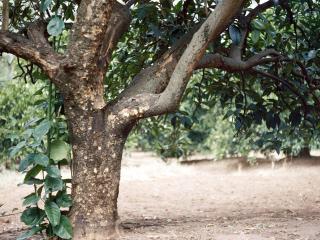Diseases of leaves and fruit
Sooty moulds
Fungi that grow on the sweet excretions ‘honeydew’ of sap-sucking insects like aphids, mealybugs or scales are commonly called sooty moulds. Sooty moulds are black and dry and look just like soot. They occur on leaves, twigs or fruits. They don’t damage the plants directly but may block enough sunlight to interfere with photosynthesis. This in turn can stunt plant growth and eventually spoil the appearance of the fruit.
To avoid sooty mould control honeydew-producing insects as well as ants which tend to ‘farm’ aphids and mealy bugs and actively transport them through the garden. An application of horticultural oil will loosen the mould deposits which can be washed from the plant with a jet of water.
Viruses
A number of viruses may affect the growth and yields of citrus trees. However, symptoms are not always obvious. The viruses include scaly butt, citrus cachexia, grapefruit and orange stem pitting virus, psorosis and tatter leaf virus.
Most virus and virus-like diseases can be avoided by the use of virus tested budwood. For disease-free budlines buy budwood from the Australian Citrus Propagation Association (trading as Auscitrus) in New South Wales. Auscitrus maintains blocks of trees that serve as a primary source of disease-free, true-to-type budwood of all important scion and rootstock varieties for Australia’s citrus industry. When purchasing citrus trees, make sure they come from a an officially accredited nursery.

